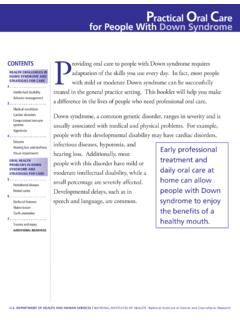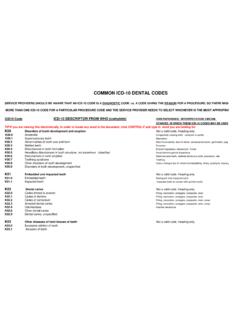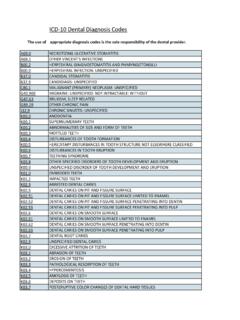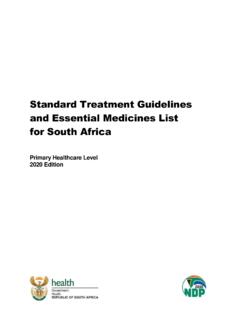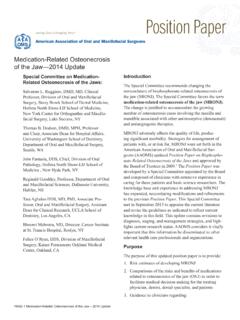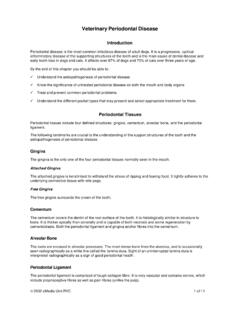Transcription of Causes, Symptoms, and Treatments
1 Periodontal (Gum) DiseaseCauses, Symptoms, and DEPARTMENT OF HEALTH AND HUMAN SERVICESN ational Institutes of Health | 1 Periodontal (Gum) DiseaseIf you have been told you have periodontal (gum) disease, you re not alone. Many adults in the currently have some form of the disease. Periodontal diseases range from simple gum inflammation to serious disease that results in major damage to the soft tissue and bone that support the teeth. In the worst cases, teeth are your gum disease is stopped, slowed, or gets worse depends a great deal on how well you care for your teeth and gums every day, from this point | Periodontal (Gum) DiseaseWhat causes gum disease?Our mouths are full of bacteria. These bacteria, along with mucus and other particles, constantly form a sticky, colorless plaque on teeth.
2 Brushing and flossing help get rid of plaque. Plaque that is not removed can harden and form tartar that brushing doesn t clean. Only a professional cleaning by a dentist or dental hygienist can remove tartar. | 3 GingivitisThe longer plaque and tartar are on teeth, the more harmful they become. The bacteria cause inflammation of the gums that is called gingivitis . In gingivitis , the gums become red, swollen and can bleed easily. gingivitis is a mild form of gum disease that can usually be reversed with daily brushing and flossing, and regular cleaning by a dentist or dental hygienist. This form of gum disease does not include any loss of bone and tissue that hold teeth in place. PeriodontitisWhen gingivitis is not treated, it can advance to periodontitis (which means inflammation around the tooth ).
3 In periodontitis, gums pull away from the teeth and form spaces (called pockets ) that become infected. The body s immune system fights the bacteria as the plaque spreads and grows below the gum line. Bacterial toxins and the body s natural response to infection start to break down the bone and connective tissue that hold teeth in place. If not treated, the bones, gums, and tissue that support the teeth are destroyed. The teeth may eventually become loose and have to be removed. 4 | Risk Factors Smoking. Need another reason to quit smoking? Smoking is one of the most significant risk factors associated with the development of gum disease. Additionally, smoking can lower the chances for successful treatment. Hormonal changes in girls/women. These changes can make gums more sensitive and make it easier for gingivitis to develop.
4 Diabetes. People with diabetes are at higher risk for developing infections, including gum disease. Other illnesses and their Treatments . Diseases such as AIDS and its Treatments can negatively affect the health of gums, as can Treatments for cancer. Medications. There are hundreds of prescription and over the counter medications that can reduce the flow of saliva, which has a protective effect on the mouth. Without enough saliva, the mouth is vulnerable to infections such as gum disease. And some medicines can cause abnormal overgrowth of the gum tissue; this can make it difficult to keep teeth and gums clean. Genetic susceptibility. Some people are more prone to severe gum disease than others. | 5 Who gets gum disease?People usually don t show signs of gum disease until they are in their 30s or 40s.
5 Men are more likely to have gum disease than women. Although teenagers rarely develop periodontitis, they can develop gingivitis , the milder form of gum disease. Most commonly, gum disease develops when plaque is allowed to build up along and under the gum line. How do I know if I have gum disease?Symptoms of gum disease include: Bad breath that won t go away Red or swollen gums Tender or bleeding gums Painful chewing Loose teeth Sensitive teeth Receding gums or longer appearing teethAny of these symptoms may be a sign of a serious problem, which should be checked by a dentist. At your dental visit the dentist or hygienist should: Ask about your medical history to identify underlying conditions or risk factors (such as smoking) that may contribute to gum disease. Examine your gums and note any signs of | Use a tiny ruler called a probe to check for and measure any pockets.
6 In a healthy mouth, the depth of these pockets is usually between 1 and 3 millimeters. This test for pocket depth is usually dentist or hygienist may also: Take an x-ray to see whether there is any bone loss. Refer you to a periodontist. Periodontists are experts in the diagnosis and treatment of gum disease and may provide you with treatment options that are not offered by your is gum disease treated?The main goal of treatment is to control the infection. The number and types of treatment will vary, depending on the extent of the gum disease. Any type of treatment requires that the patient keep up good daily care at home. The doctor may also suggest changing certain behaviors, such as quitting smoking, as a way to improve treatment outcome. | 7 Deep Cleaning (Scaling and Root Planing)The dentist, periodontist, or dental hygienist removes the plaque through a deep-cleaning method called scaling and root planing.
7 Scaling means scraping off the tartar from above and below the gum line. Root planing gets rid of rough spots on the tooth root where the germs gather, and helps remove bacteria that contribute to the disease. In some cases a laser may be used to remove plaque and tartar. This procedure can result in less bleeding, swelling, and discomfort compared to traditional deep cleaning may be used with treatment that includes scaling and root planning, but they cannot always take the place of surgery. Depending on how far the disease has progressed, the dentist or periodontist may still suggest surgical treatment. Long-term studies are needed to find out if using medications reduces the need for surgery and whether they are effective over a long period of time. Listed on the next page are some medications that are currently | MedicationsWhat is it?
8 Prescription antimicrobial mouthrinseA prescription mouthrinse containing an antimicrobial called chlorhexidineAntiseptic chipA tiny piece of gelatin filled with the medicine chlorhexidineAntibiotic gelA gel that contains the antibiotic doxycyclineAntibiotic microspheresTiny, round particles that contain the antibiotic minocyclineEnzyme suppressantA low dose of the medication doxycycline that keeps destructive enzymes in checkOral antibioticsAntibiotic tablets or capsules | 9 Why is it used? How is it used?To control bacteria when treating gingivitis and after gum surgeryIt s used like a regular control bacteria and reduce the size of periodontal pocketsAfter root planing, it s placed in the pockets where the medicine is slowly released over control bacteria and reduce the size of periodontal pocketsThe periodontist puts it in the pockets after scaling and root planing.
9 The antibiotic is released slowly over a period of about seven days. To control bacteria and reduce the size of periodontal pocketsThe periodontist puts the microspheres into the pockets after scaling and root planing. The particles release minocycline slowly over hold back the body s enzyme response If not controlled, certain enzymes can break down gum tissueThis medication is in tablet form. It is used in combination with scaling and root the short term treatment of an acute or locally persistent periodontal infectionThese come as tablets or capsules and are taken by | Periodontal (Gum) DiseasePeriodontal (Gum) DiseaseSurgical TreatmentsFlap Surgery. Surgery might be necessary if inflammation and deep pockets remain following treatment with deep cleaning and medications.
10 A dentist or periodontist may perform flap surgery to remove tartar deposits in deep pockets or to reduce the periodontal pocket and make it easier for the patient, dentist, and hygienist to keep the area clean. This common surgery involves lifting back the gums and removing the tartar. The gums are then sutured back in place so that the tissue fits snugly around the tooth again. After surgery the gums will heal and fit more tightly around the tooth. This sometimes results in the teeth appearing and Tissue Grafts. In addition to flap surgery, your periodontist or dentist may suggest procedures to help regenerate any bone or gum tissue lost to periodontitis. Bone grafting, in which natural or synthetic bone is placed in the area of bone loss, can help promote bone growth. A technique that can be used with bone grafting is called guided tissue regeneration.



